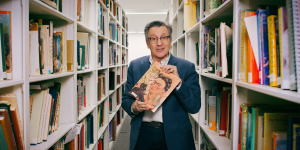A 15th-century island monastery in Croatia has been lovingly brought back to life over 20 years. Now, this idyllic sanctuary for the soul is open to all
W
hen a building has truly beautiful bones, it’s amazing the indignities it can survive. This is surely true of the monastery on the dainty little island of Lopud – a car-free paradise that’s just a 15-minute speed-boat taxi ride away from the coast of Dubrovnik in Croatia. Built in 1483, the fortified monastery housed Franciscan monks in its 12 tiny cells until the early 19th century, resisting a fair few Ottoman attacks, and then lay empty and decaying for 200 years, apart from a fleeting occupation by Italian fascists in the early 1940s.

But in 1992, it came to the attention of Francesca Thyssen-Bornemisza, and now – nearly 20 years and much restoration later – it has a new life as a discreet private getaway where the art and objets are as fine as the sense of wellbeing to be found there. “The first time I entered the ruined complex, I could sense that all of the contemplation of those Franciscan monks was still omnipresent,” says Thyssen-Bornemisza.

Thyssen-Bornemisza, who is the third generation in a family of art collectors, had come to Dubrovnik in the wake of the wars that marked the breakup of Yugoslavia. “There were still battles going on in the region,” she says, “and people in the city were starving.” Historically important artworks had also been badly damaged, and she set up a restoration studio in a Fransiscan monastery in the city where, over 10 years, 12 Renaissance masterpieces from surrounding churches were brought back to life.
One day, the head guardian of the Franciscan order, Pio Mario, took her on a boat trip, “and as soon as we turned the corner into the bay of Lopud, and I saw the monastery and its fortifications rising from the clearest of waters, I fell in love,” says Thyssen-Bornemisza. When it emerged that it was on the World Monuments Fund’s watchlist of buildings in danger, she resolved – with their help – to act. The following year, the American architect Frank Gehry gave her some sound advice as she took him around the ruins. “He said: ‘Whatever happens, take your time, get to know the building and it will tell you what it needs.’”
Living Heritage: Restoring Life to Lopud 1483
“Lopud is a place of wonder and joy, where history, art and the power of healing come together”
After some intensive but invisible engineering to shore up the building – its walls are made from shimmering pale stone from the neighbouring island of Korcula – the Zagreb-based architect Rujana Bergam Morković created a new layout inside the monastery, making clear the difference between old and new. In spite of its missing roofs and rotted upper floors, 16th-century plaster had survived. Now within its walls there are five contemporary suites on the upper floors – comfortable, but suitably low-key in their interior design thanks to the Italian Paola Lenti. On the night I stayed there, sleeping with the curtains open, I awoke in the middle of the night to find my entire bed showered with silver moonlight.

The old kitchen has become a place to gather and eat – including breads and pizzas baked in the original oven that dates back centuries, while a more formal dining room is furnished with treasures from the Thyssen-Bornemisza collection, much of which came from the family’s Villa Favorita on Lake Lugano, which was sold in 2015. The Florentine walnut table, which dates from 1550 and was once used for dinner parties at Villa Favorita, is installed here, surrounded by walnut-and-leather chairs made in Dresden in the 18th century. Furini’s florid St Sebastian from the early 1600s surveys the scene, while a 1645 Franco Maria Pretti of the liberation of St Peter is, says Thyssen, one of her favourite paintings in her family’s collection. Elsewhere superb historic pieces come into dialogue with more contemporary works: a soulful portrait of young twin boys taken by Rineke Dijkstra in Dubrovnik in 1996; a Thomas Struth photograph of the Raphaelo Chamber in the Vatican. These are from Thyssen’s own collection, TBA21, which she founded in 2002. “What you have in Lopud is the culmination of three generations of collecting and taste,” she says.

But the monastery is marked out by more than its art. Guests are encouraged to spend time in the sacred garden, designed by a shaman, with nine special meditation spots and spirals of lavender, verbena and thyme. They are encouraged to pick their own vegetables from the kitchen garden to give to the private chef, while in the Renaissance garden – an extraordinary act of restoration in itself – there are over 80 species of plants and, in the medicinal garden, herbs for every ancient remedy. “We discovered an old pharmacy dating back to the Renaissance during the restoration,” says Thyssen-Bornemisza. “So we researched the libraries in Dubrovnik for original manuscripts on medical plants dating back to those times. In the evening, in that garden, particularly after a light rain, the scents are intoxicating.”
Indeed, the concept of restoration at Lopud goes far beyond mere bricks and mortar, and Thyssen-Bornemisza will be discussing the importance of this, and the role of the World Monuments Fund in highlighting at-risk buildings, in June. In an event organised by Sotheby’s, she will be joined by the artistic director of the Serpentine, Hans Ulrich Obrist, the artist Olafur Eliasson, and the CEO of the WMF Bénédicte de Montlaur to explore the importance of developing this kind of living heritage.

“I think of Lopud as a place of healing, and wonder and joy,” says Thyssen. “And I wanted to share it with people who, like myself are interested in a place where history, art and the power of healing come together.” The monastery is available for exclusive hire from April to October. While in-room spa treatments and massages are on the menu, there’s not a pool or hot tub in sight. Swimming is done in the crystal waters of the sea – reached through a tiny cave. A personal trainer can be arranged, but there are bikes and paddleboards and kayaks to enjoy. Yoga is best practiced on the open Sunset Terrace, with views across the water, which happens to be an equally perfect spot for a cocktail. “Given the year we’ve had, we need to escape, but we need to find ourselves too,” says Thyssen-Bornemisza. Where better?

For information on Lopud 1483 and to find out more about the island, visit lopud1483.com. To watch this episode of Sotheby’s Talks, click here.


